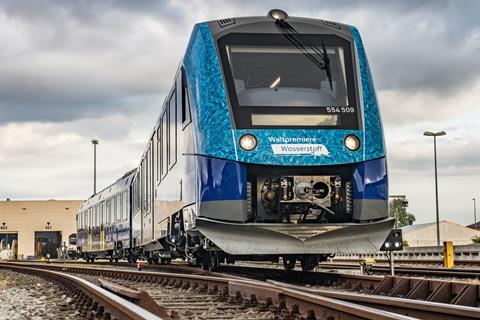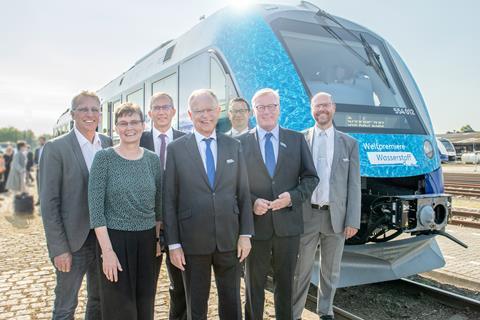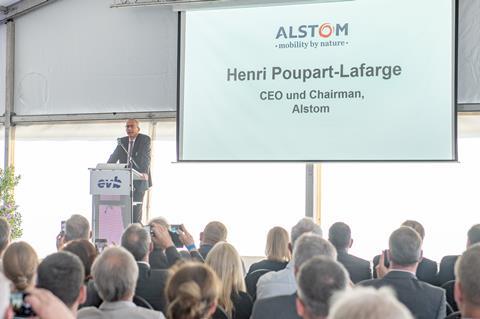
GERMANY: Regular commercial operation of series-built Alstom Coradia iLint hydrogen fuel cell multiple-units was officially launched by Eisenbahnen & Verkehrsbetriebe Elbe-Weser on August 24.
Alstom has now delivered five of the 14 iLint units which were ordered by Land transport authority LNVG in 2017, and the remaining nine are scheduled to arrive by the end of the year.
They are to replace 15 Lint 41 diesel multiple-units on Weser-Elbe-Netz regional passenger services between Cuxhaven, Bremerhaven, Bremervörde and Buxtehude which EVB operates under contract to LNVG.
iLint goes from pre-series to production
The start of regular services follows trial running with two pre-series units from September 2018 to May 2020. This included more than 180 000 km of operation over 530 days.
The production units feature improved acceleration and a larger fuel tank capacity to increase their range from 700 km to 1 000 km, enabling a full day of operation without refuelling.
Specifically developed for use on non-electrified lines, the iLint (Intelligenz eichter innovativer Nahverkehrstriebwagen, German for ‘intelligent light innovative local transport railcar’) was designed at Alstom’s regional train factory at Salzgitter in Germany and its traction systems centre at Tarbes in France. The EVB contract includes 30 years of maintenance by the manufacturer at Salzgitter.

The traction system combines a fuel cell supplied by Cummins’ Hydrogenics business with two batteries with a total capacity of 220 kWh supplied by Akasol. It has a maximum speed of 140 km/h, with the EVB units to operate at 80 to 120 km/h.
Industrial gas supplier Linde has developed the fuelling facility in Bremervörde, which has 64 storage tanks at 500 bar pressure with a total capacity of 1 800 kg, as well as six hydrogen compressors and two fuel pumps. Alstom said 1 kg of hydrogen replaces approximately 4·5 litres of diesel.
‘We have been working on hydrogen-based mobility solutions for over 30 years. We have built the most hydrogen filling stations for cars in the world. We are all the more pleased to see the world’s first filling station for trains in operation here, thus opening up a new mobility sector’, said Dr Mathias Kranz, Head of Linde’s Onsite & Bulk Business in Germany. ‘Linde is strongly committed to the further spread of sustainable hydrogen technology.’
On-site hydrogen production using wind power for electrolysis is planned for the future.
Impulse for development

LNVG started looking for alternatives to diesel trains in 2012, and its €93m hydrogen train project was supported by the German government with funding from the National Innovation Programme for Hydrogen & Fuel Cell Technology, which provided €8·4m towards the €85m cost of the vehicles and €4·3m for the fuelling station.
‘We gave an impulse for the development of hydrogen trains in Germany’, said LNVG director Carmen Schwabl. ‘We own 126 diesel multiple-units that we use on various railways in Niedersachsen. We will not buy any more diesel vehicles in order to contribute even more to climate protection. We are also convinced that diesel trains will no longer be economically viable to operate in the future.’
The experience which LNVG will gain through the commercial operation of hydrogen trains will inform its future decisions on the use of hydrogen or battery trains on other non-electrified routes.
Alstom’s ambitions
| Alstom hydrogen train orders | ||||
|---|---|---|---|---|
| Country | Type | Number | Customer | Date |
| [1] | Coradia iLint | 2 | Alstom pre-series units for testing | 2016 |
| Germany | Coradia iLint | 14 | Niedersachsen transport authority LNVG | November 2017 |
| Germany | Coradia iLint | 27 | Rhein-Main transport authority RMV | May 2019 |
| Italy | Coradia Stream | 6 (options for 8 more) | Ferrovie Nord Milano | November 2020 |
| France | Coradia Polyvalent | 12 | SNCF Voyageurs for use in Auvergne-Rhône-Alpes, Bourgogne-Franche-Comté, Grand Est and Occitanie | April 2021 |
| 1. Coradia iLint units have been demonstrated in various regions of Germany as well as in Austria, the Netherlands, Poland and Sweden. | ||||
Alstom currently has four contracts for hydrogen fuel cell powered regional trains. It said the number of diesel trains in service is still high, with more than 4 000 DMU cars in Germany, and a significant part of the European rail network is expected to remain non-electrified in the long term.

‘Emission free mobility is one of the most important goals for ensuring a sustainable future and Alstom has a clear ambition to become the world leader in alternative propulsion systems for rail’, said Chairman & CEO Henri Poupart-Lafarge, adding that the iLint ‘demonstrates our clear commitment to green mobility combined with state-of-the-art technology’.
- The Coradia iLint was described in more detail in the March 2017 issue of Railway Gazette International magazine, which subscribers can access in the digital archive.

















